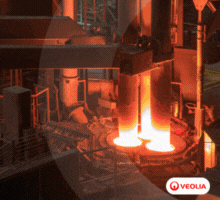EPA Report Showcases American Steel Industry’s Steep Decline in Emissions
10/13/2008 - A just-released report by the U.S. Environmental Protection Agency recognizes the American steel sector for its 67% decline of total normalized and absolute emissions between 1995 and 2006, despite production increases.
A just-released report by the U.S. Environmental Protection Agency has recognized the American steel sector as having the steepest decline of total emissions among nine manufacturing sectors studied. The report—EPA’s 2008 Sector Performance Report—notes that the steel industry reached a 67% decline of total normalized and absolute emissions between 1995 and 2006, despite production increases.
“Despite rising production and product values in the steel industry during this period, emissions dropped as a result of new steel plant technologies and greater operational and control efficiencies,” commented Tom Tyler, EPA’s national sector leader for iron and steel.
“It is through our continued investment in new steelmaking technologies and our commitment to a sustainable future that has allowed our industry to reduce our emissions and become a leader among the manufacturing sector,” said American Iron and Steel Institute (AISI) President and CEO Thomas J. Gibson.
For the past two decades, the American steel industry has also held a leading position in technology development to increase energy efficiency and mitigate CO2 emissions. By deploying new steelmaking technologies, the industry has reduced energy per ton of steel produced by 29% since 1990, the Kyoto benchmark year. In fact, the U.S. would exceed Kyoto accords if every segment of the U.S. economy had achieved the same energy improvements as the domestic steel industry.
The EPA report analyzed manufacturers of cement, chemicals, food and beverages, forest products, metal castings, paint and coatings, refined petroleum, ships, and iron and steel. According to the report, these industries represent about 35% of total air emissions reported to the EPA’s Toxic Release Inventory, which is one of many government data sources EPA used to compile its report.
AISI serves as the voice of the North American steel industry in the public policy arena and advances the case for steel in the marketplace as the material of choice. The institute plays a lead role in the development and application of new steels and steelmaking technology. AISI comprises 27 member companies, including integrated and electric furnace steelmakers, and 138 associate and affiliate members who are suppliers to or customers of the steel industry.



.jpg?lang=en-US&ext=.jpg)
-(1).gif?width=220&height=200&mediaprotectionhash=8011a71ede637cd523c67b1296fc49e6151560fde821a46f29cc85998cc76615&ext=.gif)


